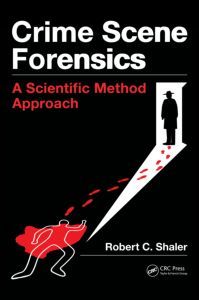Description
Crime Scene Forensics
A Scientific Method Approach
Author: Shaler Robert C
Language: English
Subjects for Crime Scene Forensics:
Keywords
Electrostatic Lifter; BPA; bias and the scientific method; Scene Investigators; forensic photography; Scene Investigation; forensic sketching; DNA Profile; fingerprints; Footwear Impression; footwear impressions; Crime Scene Unit; bloodstain patterns; Bloodstain Pattern; mass fatality; Crime Scene; clandestine laboratories; Scene Scientist; microbial forensics; Locard Exchange Principle; Dental Stone; forensics; Gel Lifter; evidence; NAS Report; Bullet Path; Crime Scene Investigators; Bullet Strike; Gelatin Lift; Powder Suspensions; Impression Evidence; Crime Scene Investigation; Forensic DNA Laboratory; Fingerprint Residue; Bloodstain Pattern Analyst; Forensic Photographer
Approximative price 123.78 €
In Print (Delivery period: 15 days).
Add to cart· 17.8x25.4 cm · Hardback
Description
/li>Contents
/li>Biography
/li>
Bridging the gap between practical crime scene investigation and scientific theory, Crime Scene Forensics: A Scientific Method Approach maintains that crime scene investigations are intensely intellectual exercises that marry scientific and investigative processes. Success in this field requires experience, creative thinking, logic, and the correct application of the science and the scientific method.
Emphasizing the necessary thought processes for applying science to the investigation, this text covers:
- The general scene investigation process, including definitions and philosophy as well as hands-on considerations
- Archiving the crime scene through photography, sketching, and video
- Managing the crime scene investigation?the glue that holds the investigation together
- Searching the crime scene?the logical byproduct of archiving and management
- Impression/pattern evidence, including fingerprints, bloodstains, footwear impressions, and tire track impressions
- The biological crime scene and recognizing, collecting, and preserving biological evidence, including forensic entomology and evidence found at bioweapon scenes
- The fundamental principles of evidence as expressed by the Principle of Divisible Matter and the Locard Exchange Principle: every touch leaves a trace
- Trace evidence, including glass, paint, and soil
- Shooting incident scenes, with discussion of bullet paths and gunshot residue
The final section examines fire scenes, quality assurance issues, and methods for collecting and preserving various evidence types not covered in other chapters.
The delicate balance among logic, science, and investigative activity must be understood in order to successfully work a crime scene. Enhanced by more than 200 color images, this volume provides investigators and students with the tools to grasp these critical concepts, paving an expeditious path to the truth.
The Philosophy and Essentials of Crime Scene Forensics. Forensic Archiving: Today’s Eye for the Future. Impression Evidence: Patterns of Identity. The Biological Crime Scene. Microscenes and Trace Evidence. Bang! It’s a Shooting Incident Scene. Miscellaneous Considerations and Specialized Scenes. Glossary. Index.
Robert C. Shaler’s research and professional interests focus on applying science and technology to crime scene investigation. His current research is related to identifying human and bacterial DNA in fingerprints and to quantifying the biological response to trauma and stress by analyzing postmortem blood and tissue. He has taught workshops to law enforcement on crime scene investigation, crime scene reconstruction, and bloodstain pattern analysis. He is the recipient of a U.S. patent for a novel method for developing fingerprints, a continuing project for which he recently received funding from the National Institute of Justice. He is the author of over 40 publications and chapters in four books.




